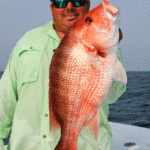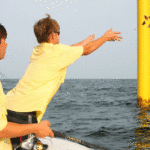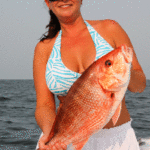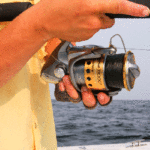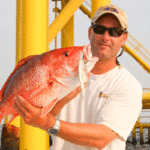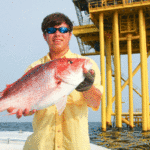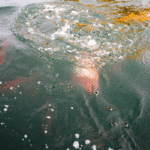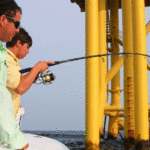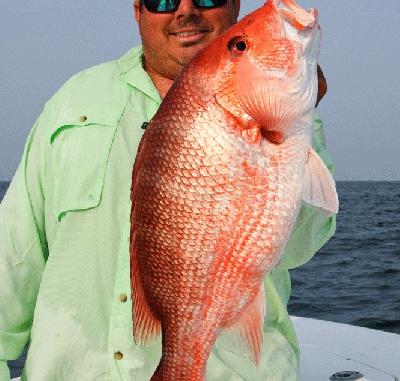
You don’t have to drop to the bottom to catch red snapper. Instead, bring them to the surface to pick your targets.
I used to be fascinated at how quickly my grandfather’s catfish would come to the surface of his two farm ponds as he drove across the field in their direction.
Before he could even get out of his truck, whiskered mouths began skimming the water’s surface in an effort to be one of the first to get what they knew was coming.
He fed his catfish on a regular schedule, and although I don’t recall how often he fed them, those catfish knew exactly when he was coming to give them something to eat.
Little did I know that when Capt. Joey Palmisano invited my wife and me on a red snapper offshore fishing trip out of Cocodrie, he would wind up evoking my bygone memories of those gluttonous catfish.
My wife Jennifer and I met up with the owner of Cocodrie Fishing Charters (985-991-3152) at the Trade Winds Marina in Cocodrie. Joining us on this trip were Palmisano’s wife Sam, his deckhand/son Billy Joe, deckhand Ethan Whitfield, Capt. Marty LaCoste, Lacoste’s wife Lena and her friend Nicole Rome.
Palmisano wanted to show me how easily he had been catching red snapper in days leading up to this trip. Little did I know that we would essentially wind up sight-fishing for snapper that looked like catfish waiting on floating fish food.
“Snapper season opened on June 1 (2011), and it’s really just been incredible,” Palmisano told me as we idled away from Cocodrie. “We’ve been fishing every day, and we’re fishing the snapper on the top.
“There’s no dropping weights down or any of that. It’s just been a neat experience to see it like that.”
Before we made it through Terrebonne Bay, Palmisano told me that the snapper he had been catching were some of the biggest and easiest-to-catch snapper he had ever been around. He and his crew had been catching a lot of 8- to 15-pound snapper, with the occasional 20-pounder mixed in. The day before this trip, he landed a 25-pound fish.
As we made our way past the beach and braced for the 26 miles we had left to go, we realized that this day was going to be a little bit bumpier than what we had anticipated. However, Palmisano didn’t see that as being a stumbling block to catching fish, even though it might make us stumble around while trying to fish.
“We’re going to pull up to a platform in the South Tim(balier) 100 block and throw some chum out to get the snapper up to the surface,” he explained over the roaring drone of the three motors propelling the boat. “Then all we’re going to have to do is get some baits in the water. You should be able to pick out the snapper you want to catch.”
As our target rig began to grow larger on the horizon, I asked Palmisano if he would be able to duplicate this same kind of fishing at all the other rigs to the east and west of this particular one.
Apparently, there was more to this rig than met the eye.
“We’ve been fishing this same rig on all our offshore trips,” Palmisano said. “This is our first stop on the way out, and our last stop on the way in. On the way out, we would stop to catch our snapper, and on the way in we would stop to completely discharge any bait we had left.”
I likened all this chumming action to my grandfather feeding his catfish. Although there is such a good population of red snapper around all the rigs that were within sight, those suspended near this particular rig were used to eating well.
As we pulled up to the rig, Palmisano pointed to his depth finder to show me the snapper schooled up about 30 feet down over 60 feet of water.
Needless to say, they wouldn’t stay down that deep very long.
Just seconds after Billy Joe Palmisano and Ethan Whitfield tossed a few handfuls of pogie chunks, the water below turned into a shimmering orange tornado of color. The men then threaded dead sardines onto our hooks and told us to start fishing.
We quickly put together an assembly line of anglers fighting fish toward the back of the boat. Cast, hook, fight, walk, net, unhook, back to the front: That was the order of events for the next 25 minutes as we wrapped up a nine-man limit of 18 snapper in under 30 minutes.
We couldn’t have caught Paw-Paw’s catfish any faster than that.
To get the most action, Palmisano made sure to position his boat on the downcurrent side of the rig and had his deckhands toss the chum up toward the rig. This way, the current would sweep the chum back to the boat rather than away from it.
“You’ve got to get on the downcurrent side if you want to catch any fish,” he told me later. “Otherwise, if you get on the upcurrent side, the current would push your bait into the rig and out the other side. That would put all the snapper feeding on the other side of the rig opposite your boat.”
As it was on this trip, we didn’t have that problem. At one point, Palmisano pointed to his depth finder screen again to show me that it was completely blacked out because of the hundreds of snapper under us.
And to hear him talk about it now, there shouldn’t be any problem in Palmisano repeating these kinds of trips this year. During the offshore trips he’s already taking so far this year, he’s found many of the rigs he’s fished full of snapper.
“So far, most rigs we pull up to in the snapper grounds realistically have hundreds of snapper on them,” Palmisano noted. “And not just out of Cocodrie. The same thing is happening out of Fourchon and Grand Isle, so it’s not just in one area.
“Outside of South Tim, this is stretched out at least until Venice. I can’t speak for anything beyond that, but these snapper — there are thousands of them on the platforms.”
In fact, there are so many snapper that Palmisano is finding it challenging to catch anything else. Because they are a really dominate fish, they run the mangrove snapper off the chum, and they have posed a problem in catching other species.
“Especially trigger fish,” Palmisano said. “It’s getting hard to catch them because it’s just snapper after snapper after snapper. When you throw the chum out, the red snapper come up and anything else that hits the water they’re eating.
“You just can’t get a bait past them.”
As we were loading snapper into the ice chest, Palmisano left me with this final thought: One of the reasons he likes catching schooling snapper on the surface like this is because he can catch and release them without any harm coming to the fish.
“When you start dragging up snapper 100 feet off the bottom, their insides are hanging out,” he said. “You pop them with that venting tool, (but) it’s hard for me to believe there’s no harm coming to those fish.
“Whenever you sticking a hole in something, to me, there’s going to be a problem.”
Sight-fishing red snapper at the surface allows Palmisano to catch fish and let them go with the assurance that, for the most part, no harm will come to them.
And sight-fishing red snapper is available to anybody who has a boat capable of running about 25 miles off shore. Other than a sound boat, no other specialized tackle is needed.
We caught our fish with standard Shimano spinning reels and Shimano rods spooled with 60-pound-test line with fluorocarbon leaders tied to small circle hooks.
And it didn’t take me long to figure out that I couldn’t set the hook on a snapper like I would on a redfish or a bass. When I did that, all I did was pull the bait out of their mouths.
Palmisano convinced me that all I had to do with the circle hook was slowly increase pressure and the fish would hook itself, and I eventually settled on steadily reeling while pulling the rod up about 45 degrees when I felt the weight of the fish.
These red snapper definitely aren’t my grandfather’s catfish, but they sure acted like them. Throw some food out, wait for them to come to the top and throw a bait into the middle of the fray.
Now if Palmisano could only figure out how to get them up to the surface when they hear his boat coming.
